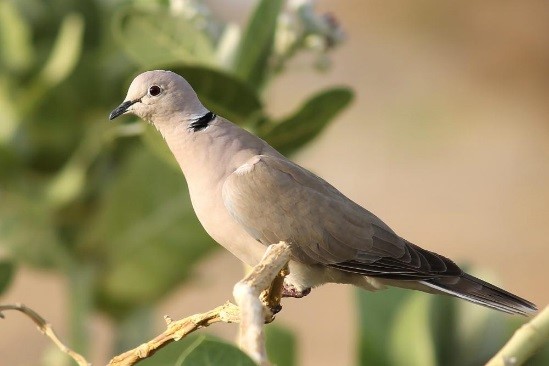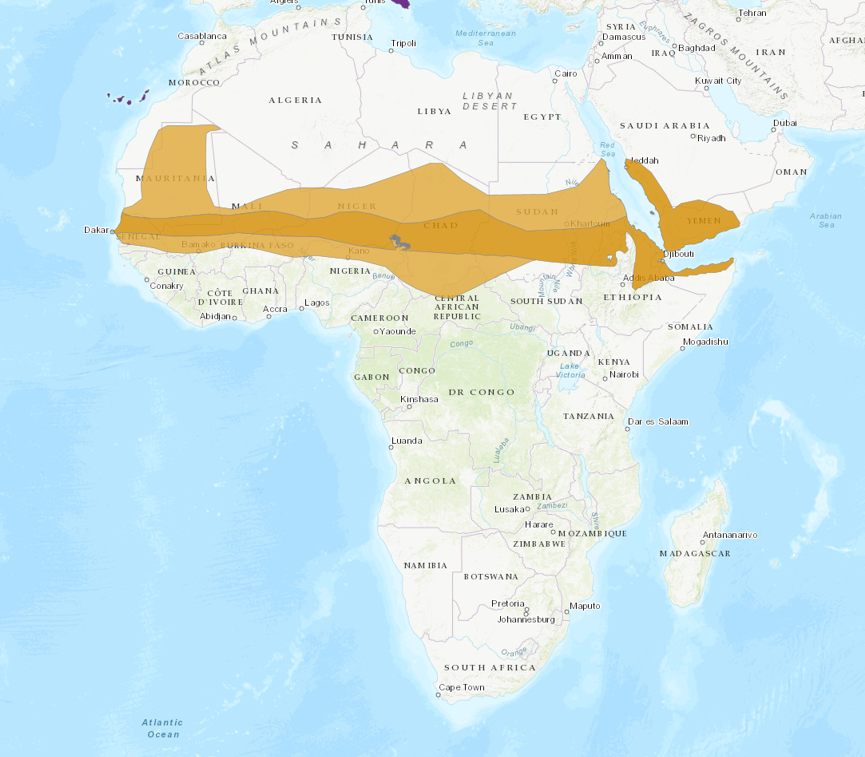Birdfinding.info ⇒ Uncommon or sporadic across much of its natural range. Areas where it is regularly reported include southern Saudi Arabia around Jizan, the interior of Djibouti, Aledeghi Wildlife Reserve and Awash National Park in Ethiopia, Zakouma National Park in Chad, Waza National Park in Cameroon, and along the Senegal River from Richard Toll to Ndioum. In the Canary Islands it is readily observed on Tenerife, Gran Canaria, Fuerteventura, and Lanzarote, and in Puerto Rico most consistently in the northwest and southwest at sites including Camuy and La Parguera. New Zealand’s “Barbary Doves” can be found around several towns, including Auckland, Hamilton, and Wairau Bar (South Island).
African Collared-Dove
Streptopelia roseogrisea
Arid scrublands of North Africa and the Arabian Peninsula.
Native to the Sahel and southern portions of the Sahara Desert from Western Sahara, Mauritania, and Senegal east to the Red Sea coastal plain from central Egypt to Somaliland. Also on the western and southern Arabian Peninsula, along the Red Sea from Duba south, and east throughout Yemen to southern Oman.
Introduced populations are well-established on Puerto Rico and the Canary Islands—where it is resident on all the major islands except for El Hierro and La Palma.
The “Barbary Dove” (“risoria”, a pale domesticated variant) is well established on New Zealand’s North Island, and locally on South Island (at the northern end and around Christchurch), with numerous additional feral populations worldwide, though most are small and not self-sustaining.
Identification
A sandy-brown turtle-dove with a black half-collar and black-and-white tail pattern (usually visible only when the tail is spread).
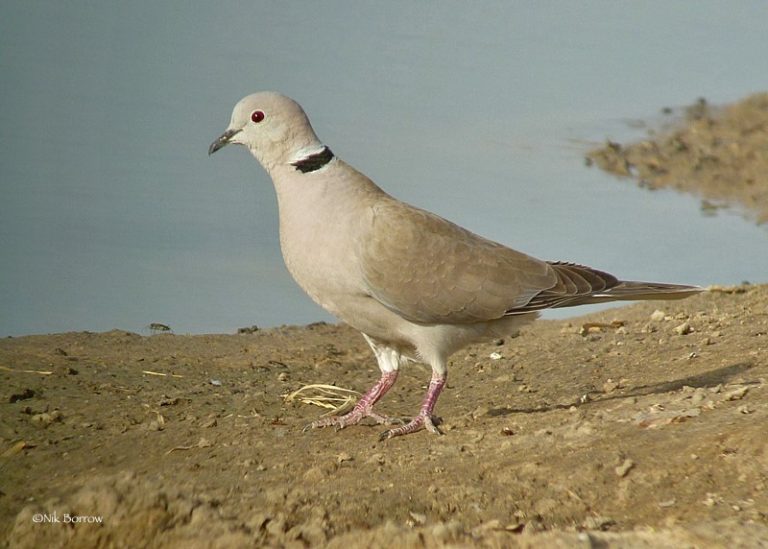
African Collared-Dove, showing whitish borders above and below black half-collar. (Waza National Park, Cameroon; March 11, 2011.) © Nik Borrow
At rest, the wings and back are typically pale-brown, while the head, neck and body are tan or whitish—but often with a subtle pinkish blush. Overall coloration varies, however, with many individuals showing darker-brown upperparts.
The black half-collar is accentuated by a distinct whitish border above and a less distinct whitish border below.
Several other Streptopelia species are distinguishable by voice, eye and orbital skin coloration, and aspects of the wing and tail patterns that are most visible in flight. In some areas it overlaps with its very similar northern relative, the Eurasian Collared-Dove (decaocto), which is spreading globally due to its close association with human development—voice is the best, and often the only, reliable means of identification (see detailed comparison below).
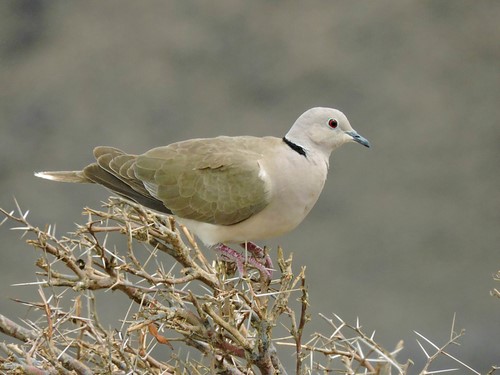
African Collared-Dove, appearing atypically dark, olive-brown above. (Balho, Djibouti; July 29, 2014.) © Andrew Cauldwell
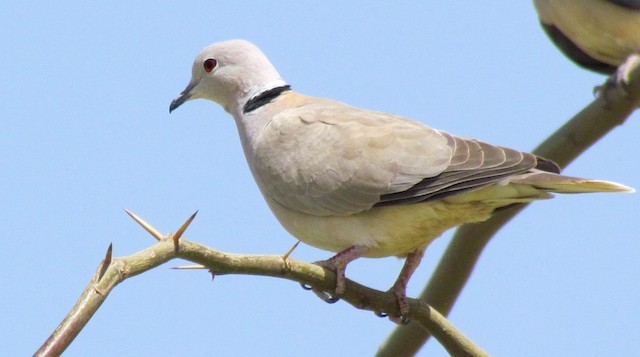
African Collared-Dove, showing pale, sand-colored upperparts. (Fire, Kanem, Chad; February 4, 2014.) © Zlatan Celebic
The eyes are dark-red, but often appear dark-brown or black when not fully illuminated. The orbital skin is whitish or very pale powder-yellow.
The legs are typically reddish, but vary from pink to dull-purplish or dark-gray.
The undertail, including the coverts, usually appears whitish overall, with little contrast between the coverts and the tail feathers—which differs from typical Eurasian Collared-Dove undertail coloration.
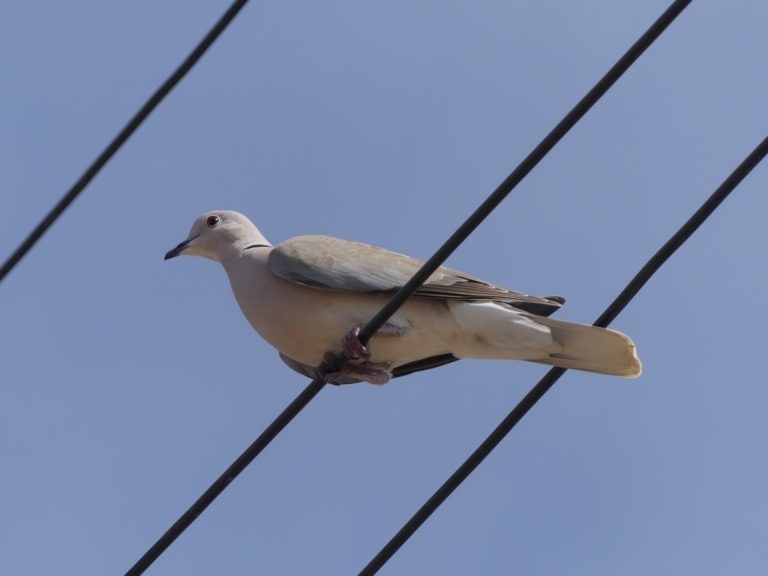
African Collared-Dove, showing apparently all-white undertail when the tail is folded. (Ghela’elo, Semien-Keih-Bahri, Eritrea; February 24, 2020.) © Tommaso Renzulli
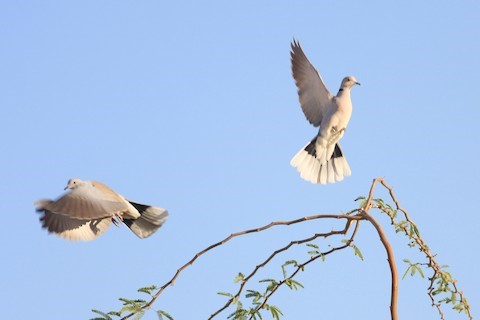
African Collared-Doves flushing from their perch—note the white undertail coverts and tail-feathers with contrasting black triangles at the base of the outer tail-feathers. (Mudday, Dhofar, Oman; December 4, 2015.) © Oscar Campbell
When spread, the undertail is mostly whitish with black corners at the base of the outer tail-feathers.
Seen from above, when the tail is spread, the outer corners are whitish, the base is dark gray, and the rump and central tail feathers form a brownish wedge in the middle.
In flight, the uppersides of the wings show a broad pale-gray diagonal band between the blackish primaries and pale-brown inner coverts.
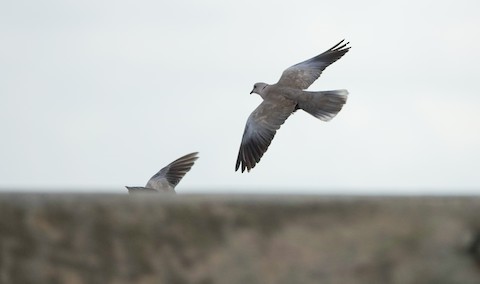
African Collared-Dove, showing gray crescent on upperwing and white corners on uppertail. (Arecibo, Puerto Rico; February 21, 2019.) © Scott Stafford
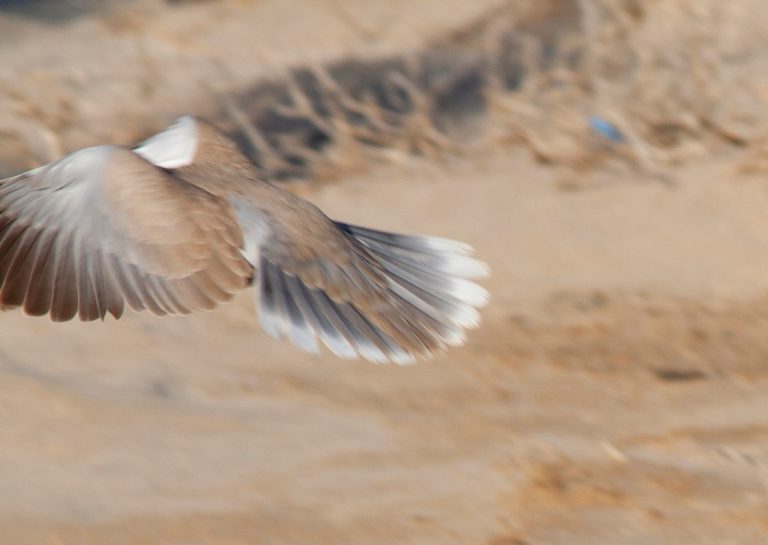
African Collared-Dove, showing dark-gray base and white outer corners. (Hurghada, Egypt; May 3, 2010.) © Tero Linjama
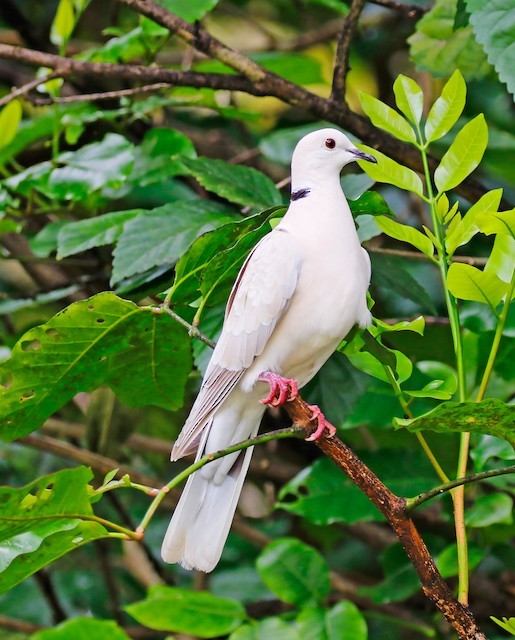
“Barbary Dove”, S. r. “risoria”, showing small blackish corners at the base of the undertail. (Aroha Island, New Zealand; October 9, 2016.) © Olivia Graves
“Barbary Dove”. The domestic variant, also known as the “Ringed Turtle Dove” (“risoria”), is much paler than the wild subspecies, but variable. Most “Barbary” individuals appear uniformly sandy-beige or whitish overall with no black on the tail. Most individuals have a black half-collar, but it is often narrow and indistinct.
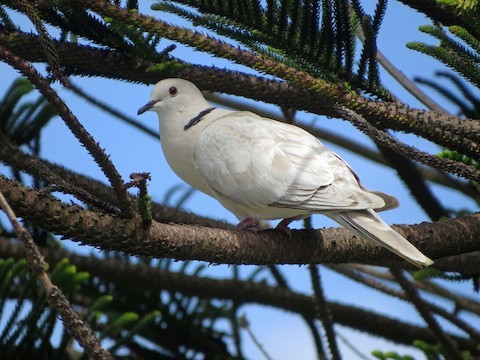
“Barbary Dove”, S. r. “risoria”. (Muriwai, North Island, New Zealand; December 14, 2018.) © Tom Edell
Voice. Typical call has two parts, starting with a sharp, emphatic note then a drawn-out, rolling purr, CU-currRRUuuu: Sometimes punctuated by another emphatic note at the end, CU-currRRUuu-HUu:
Notes
Polytypic species consisting of two recognized wild subspecies, roseogrisea and arabica, and one domestic or feral form, “risoria” (often known as the “Barbary Dove” or “Ringed Turtle-Dove”). “Risoria” was formerly considered a distinct species, but its validity is unsettled.
See below for a comparison of the African Collared-Dove with the Eurasian Collared-Dove.
Cf. Eurasian Collared-Dove. The Eurasian and African Collared-Doves do not occur together naturally, but their close associations with humanity increasingly bring them into contact: in West Africa, the Arabian Peninsula, the Canary Islands, and Puerto Rico.
They can be essentially identical, with overlapping measurements and general coloration, and limited differentiation in their plumage patterns. Eurasian is somewhat larger on average, both longer and bulkier, but the size differences are not pronounced or consistent enough to be reliable in field identification.
Voice: Their most reliable distinguishing feature is their typical vocalizations. Eurasian gives a relatively clear, rhythmic, three-syllable call, whereas African gives a rolling, purring call. These typical calls are usually diagnostic. But some Eurasian calls are rougher than average, some African calls are clear, and both can vary in their cadences, so voice is not always a certain indicator.
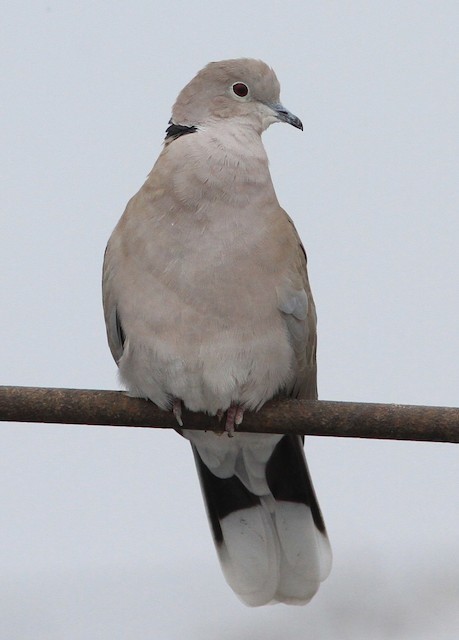
Eurasian Collared-Dove, showing extensive black base on underside of folded tail. (Sangamon, Illinois; January 4, 2015.) © Dennis Oehmke
Undertail Pattern: Apart from vocalizations, the most consistent diagnostic differences are in the undertail. Both species have extensive white tips and a black base, but they differ in the amount of black and the coloration of the undertail coverts. The black base on Eurasian’s undertail is usually visible when the tail is folded, whereas African typically shows a smaller black area that becomes visible only when the tail is spread. Eurasian’s undertail coverts are usually grayish, darker the white of the tail-feathers, whereas African’s undertail coverts are whitish, about the same shade as the tail-feathers, or sometimes paler. However, these differences are tendencies, not 100% consistent.
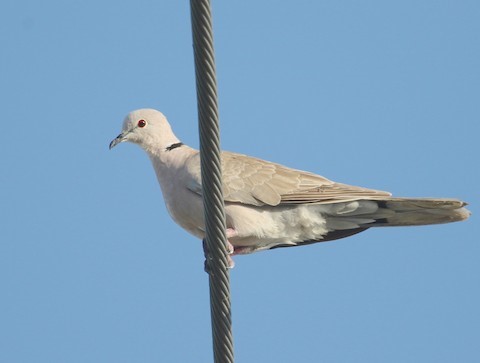
African Collared-Dove, showing mostly white undertail with narrow blackish corners at the base. (Levittown, Toa Baja, Puerto Rico; February 28, 2017.) © Gil Ewing
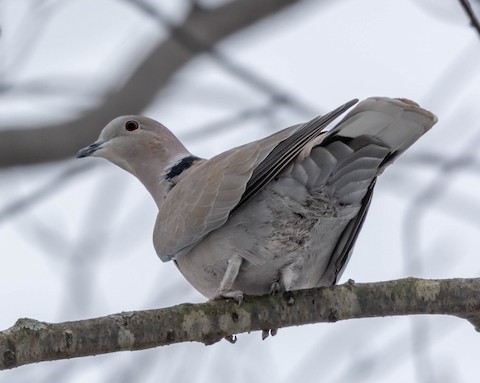
Eurasian Collared-Dove, showing gray undertail coverts contrasting with whiter tail feathers. (Manhattan, Illinois; January 18, 2019.) © Jim Lukancic
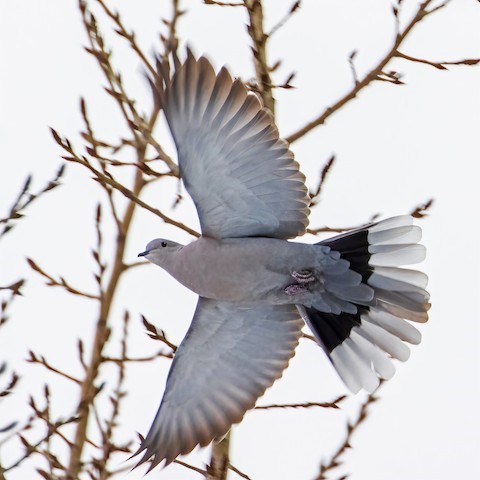
Eurasian Collared-Dove, showing gray undertail coverts contrasting with black-and-white tail-feathers. (Sainte-Marthe, Vaudreuil-Soulanges, Quebec; January 12, 2021.) © Michel Laquerre
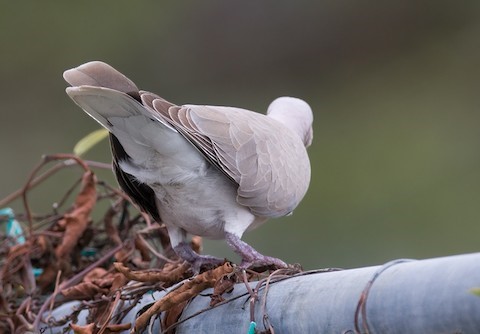
African Collared-Dove, showing uniformly whitish undertail—with no contrast between the coverts and tail-feathers. (Cabo Rojo, Puerto Rico; April 14, 2009.) © Bill Hubick
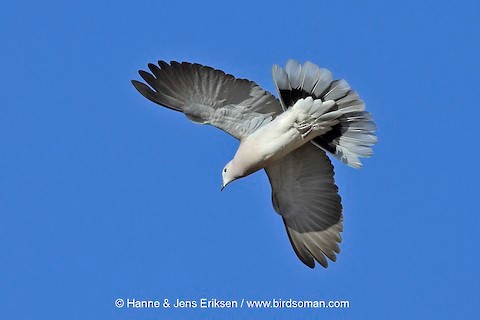
African Collared-Dove, showing essentially concolor undertail coverts and undertail—whether more whitish or grayish (as they appear in this photo), the lack of contrast is more typical of African than Eurasian. (Al Mazyunah, Dhofar, Oman; February 17, 2016.) © Jens Eriksen
Upperparts Coloration: Eurasian’s upperparts tend to appear somewhat browner and darker, often contrasting with its pale head and neck, whereas African’s upperparts tend to appear more uniform and sand-colored. However, these differences in coloration are variable, with broad overlap between the two species, and mostly unreliable for identification.
Uppertail Pattern: Some identification references depict differences in the uppertail patterns—showing African with a pronounced brown wedge between the black base and white outer tips, and showing Eurasian with a broader band of white—but this is not a reliable distinction.
Wings: Some identification references depict differences in wing patterns—showing Eurasian with more contrasting coloration on both the upperside and the underside—but these are not reliable distinctions. On the upperside of the spread wing, both species have dark primaries and sandy coverts, and both can show a bright pale gray patch in mid-wing—Eurasian apparently always has this patch, but African can show it as well. On the underside of the wing, Eurasian tends to appear mostly whitish, whereas African often shows a more neutral grayish tone—but these appearances depend on lighting and both species seem to vary.
More Images of the African Collared-Dove

African Collared-Dove. (La Parguera, Puerto Rico; April 7, 2017.) © James Thompson
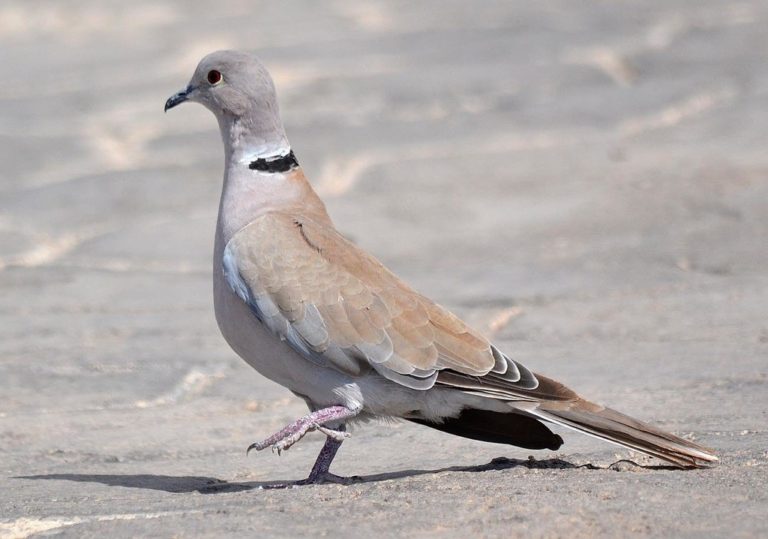
African Collared-Dove. (Amarilla Golf Course, Tenerife, Canary Islands, Spain; July 27, 2014.) © A. Emmerson
References
Alderfer, J., and J.L. Dunn. 2014. National Geographic Complete Birds of North America (Second Edition). National Geographic Society, Washington, D.C.
BirdLife International. 2018. Streptopelia roseogrisea. The IUCN Red List of Threatened Species 2018: e.T22690515A133401762. https://dx.doi.org/10.2305/IUCN.UK.2018-2.RLTS.T22690515A133401762.en. (Accessed February 25, 2022.)
Borrow, N., and R. Demey. 2004. Birds of Western Africa. Princeton University Press.
eBird. 2022. eBird: An online database of bird distribution and abundance. Cornell Lab of Ornithology, Ithaca, N.Y. http://www.ebird.org. (Accessed February 26, 2022.)
Frost, P.G.H. 2013. Barbary dove. In New Zealand Birds Online (Miskelly, C.M., ed.). https://nzbirdsonline.org.nz/species/barbary-dove. (Accessed February 25, 2022.)
Garcia-del-Rey, E. 2018. Birds of the Canary Islands. Christopher Helm, London.
Gibbs, D., E. Barnes, and J. Cox. 2001. Pigeons and Doves: A Guide to the Pigeons and Doves of the World. Yale University Press, New Haven, Connecticut.
Kirwan, G.M., A. Levesque, M. Oberle, and C.J. Sharpe. 2019. Birds of the West Indies. Lynx Edicions, Barcelona.
Porter, R.F., S. Christensen, and P. Schiermacker-Hansen. 1996. Field Guide to the Birds of the Middle East. T & A D Poyser, London.
Redman, R., T. Stevenson, T., and J. Fanshawe. 2009. Birds of the Horn of Africa: Ethiopia, Eritrea, Djibouti, Somalia, and Socotra. Princeton University Press.
Sinclair, I., and P. Ryan. 2003. Birds of Africa South of the Sahara. Princeton University Press.
van Perlo, B. 2002. Birds of Western and Central Africa. Princeton University Press, Princeton, N.J.
Xeno-Canto. 2022. African Collared Dove – Streptopelia roseogrisea. https://xeno-canto.org/species/Streptopelia-roseogrisea. (Accessed February 25, 2022.)
